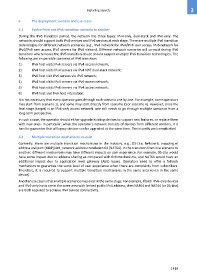Page 1429 - 5G Basics - Core Network Aspects
P. 1429
Signalling aspects 3
6 The deployment scenario and use cases
6.1 Evolve from one IPv6 transition scenario to another
During the IPv6 transition period, the network has three types: IPv4-only, dual-stack and IPv6-only. The
networks should support both IPv4 services and IPv6 services at each stage. There are multiple IPv6 transition
technologies for different network scenarios (e.g., IPv4 network for IPv4/IPv6 user access, IPv6 network for
IPv4/IPv6 user access, IPv4 servers for IPv6 visitors). Different network scenarios will co-exist during IPv6
transition which means the IPv6 transition device should support multiple IPv6 transition technologies. The
following are six possible scenarios of IPv6 transition:
1) IPv6 host visits IPv6 servers via IPv4 access network;
2) IPv4 host visits IPv4 servers via IPv4 NAT dual-stack network;
3) IPv6 host visit IPv6 servers via IPv6 network;
4) IPv4 host visits IPv4 servers via IPv6 access network;
5) IPv6 host visits IPv6 servers via IPv4 access network;
6) IPv4 host and IPv6 host interaction.
It is not necessary that every operator goes through each scenario one by one. For example, some operators
may start from scenario 1), and some may start directly from scenario 2) or scenario 4). However, since the
final stage (target) is an IPv6-only access network, one still needs to go through multiple scenarios from a
long-term perspective.
In such a case, the operator should either upgrade existing devices to support new features, or replace them
with new ones. In particular, when the operator's network consists of devices from different vendors, it is
hard to guarantee that all legacy devices can be upgraded at the same time. This is costly and complicated.
6.2 Multiple transition mechanisms co-exist
Currently, there are multiple transition mechanisms in the industry, e.g., DS-Lite, lw4over6, mapping of
address and port (MAP)/4rd, network address translation 64 (NAT64). In the transition from one scenario to
another, different mechanisms may have different impacts on user experience. For example, DS-Lite would
have some impact due to address sharing as compared with 6rd mechanisms, and NAT64 would have an
additional impact due to application level gateway (ALG) issues. Operators need to offer a fallback
mechanism to guarantee the same level of user experience when there are complaints from subscribers.
Therefore, it is required to support multiple transition mechanisms in the same area (even in the same
device).
Another use case is that multiple scenarios may exist in the same stage. For example, if both IPv6-only devices
and IPv4-only hosts are in the same area with limited public IPv4 address, then NAT64 and NAT44 (or DS-Lite)
are both required to achieve IPv4 service connectivity.
1419

